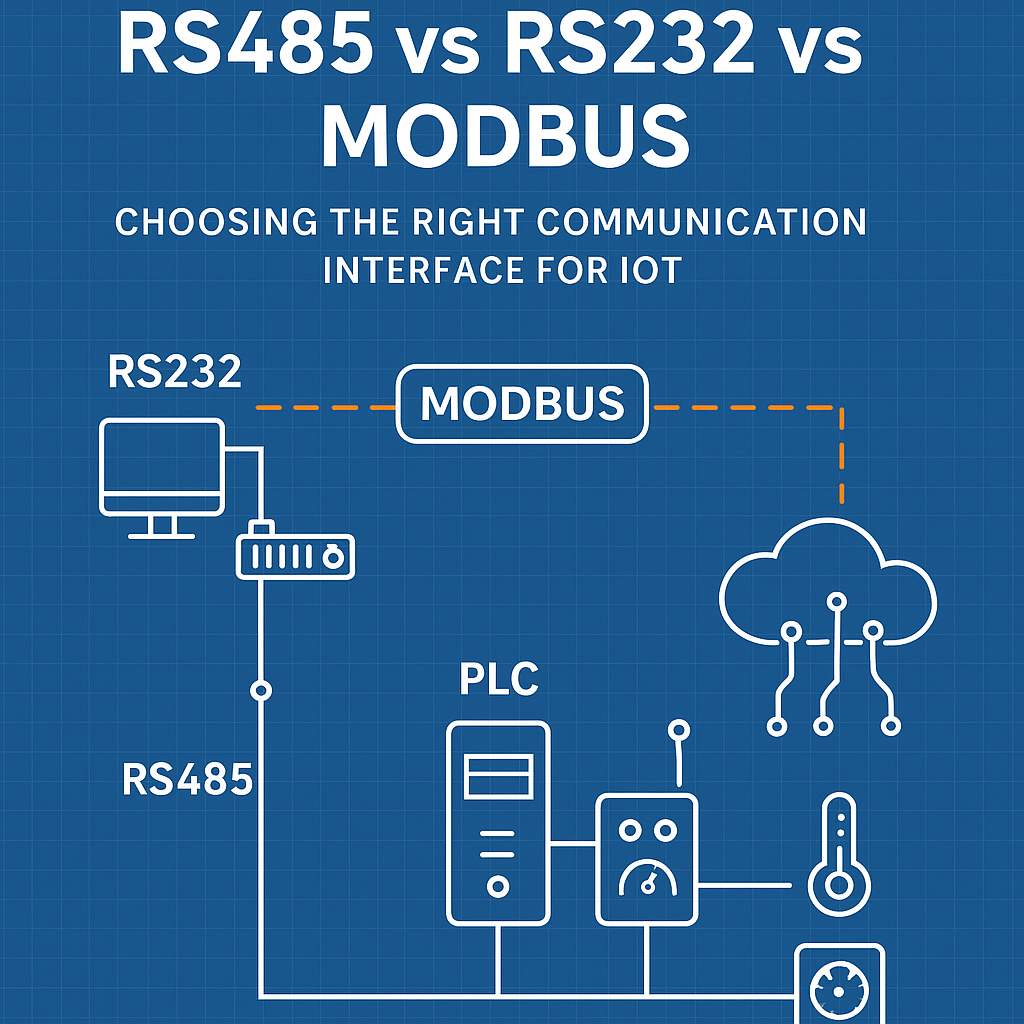In the world of Industrial IoT (IIoT), seamless communication between sensors, controllers, and cloud platforms is the backbone of a reliable system. When planning your IoT architecture, understanding the differences between RS485, RS232, and Modbus is crucial — especially when choosing the right IoT gateway for your application.
This blog will break down the fundamentals of each protocol/interface, their advantages, differences, and where each fits best in modern IoT systems.
🔌 What Are RS485, RS232, and Modbus?
Before we compare them, let’s define what they actually are:
▶ RS232 – The Original Serial Standard
RS232 is a point-to-point serial communication standard introduced in the 1960s. It was widely used for computer serial ports, connecting devices like modems, printers, and industrial controllers.
- Max distance: ~15 meters
- Max devices: 1 transmitter + 1 receiver (duplex)
- Wiring: Unbalanced (single-ended)
- Speed: Up to 115.2 kbps (theoretically)
✅ Best for short-distance, low-noise environments
▶ RS485 – Rugged Industrial Favorite
RS485 is a differential serial communication standard widely used in industrial automation due to its robustness over long distances and ability to support multiple devices on a single bus.
- Max distance: ~1200 meters
- Max devices: Up to 32 nodes (or more with repeaters)
- Wiring: Balanced (differential pair)
- Speed: Up to 10 Mbps (at shorter distances)
✅ Ideal for noisy industrial environments, multi-device networks, and remote sensor data acquisition
▶ Modbus – The Protocol Layer
Unlike RS232 or RS485 (which are physical layer standards), Modbus is a communication protocol that can run over RS232, RS485, or TCP/IP (Ethernet). It defines how devices on a network communicate.
- Types: Modbus RTU (binary), Modbus ASCII, Modbus TCP (over Ethernet)
- Master-slave architecture
- Popular in: PLCs, meters, sensors, SCADA systems
✅ Great for standardized industrial communication, compatible with hundreds of device vendors
⚖️ RS485 vs RS232: Key Differences
| Feature | RS232 | RS485 |
|---|---|---|
| Topology | Point-to-point | Multi-drop (bus) |
| Distance | ~15 meters | ~1200 meters |
| Devices | 1-to-1 | Up to 32 (or more) |
| Noise Resistance | Low | High |
| Cost | Low | Moderate |
| Speed | Up to 115.2 kbps | Up to 10 Mbps |
| Common Use | PCs, modems, legacy devices | Industrial networks, field sensors |
🔁 Modbus Over RS232 vs RS485
| Parameter | Modbus over RS232 | Modbus over RS485 |
|---|---|---|
| Network Size | 1-to-1 | 1 master, multiple slaves |
| Noise Immunity | Low | High |
| Scalability | Limited | Highly scalable |
| Usage | Simple device communication | Industrial automation systems |
💡 Best Practice: Use Modbus RTU over RS485 for robust, scalable communication with sensors, actuators, and PLCs in industrial environments.
💼 Use Cases for Each Interface
✅ RS232:
- Point-to-point control between a PC and a legacy machine
- Configuration interfaces for embedded systems
- Short-distance modem or GPS module communication
✅ RS485:
- SCADA systems
- Smart energy meters
- Industrial automation (PLCs, HMIs)
- Smart HVAC, irrigation, or lighting controllers
✅ Modbus:
- Factory automation and robotics
- Remote monitoring for utilities
- Industrial process control
- IoT gateways bridging legacy protocols to the cloud
🧠 Choosing the Right Interface for Your IoT Gateway
When selecting an IoT gateway, think about:
- Distance: Choose RS485 if communication spans hundreds of meters.
- Number of Devices: RS485 supports multi-device networks; RS232 does not.
- Protocol Support: Modbus adds standardization and device interoperability.
- Noise Environment: RS485 handles EMI better — perfect for noisy industrial setups.
Example:
A smart energy monitoring setup with 15 power meters across a factory floor?
👉 Use RS485 with Modbus RTU for long-distance, reliable data collection.
A point-to-point configuration between a local control panel and a single sensor?
👉 RS232 is simpler and cheaper.
🔗 How HashStudioz Empowers Your RS485/Modbus IoT Projects
At HashStudioz Technologies, we specialize in custom IoT gateway development, including:
- RS485-based IoT gateways
- RS232 to MQTT/LoRaWAN converters
- Modbus RTU to Modbus TCP/IP bridges
- Edge computing-enabled data acquisition units
Our gateways are field-tested across industries like manufacturing, smart cities, agriculture, utilities, and energy. With features like 4G/5G, Wi-Fi, MQTT, and cloud integration, we help future-proof your legacy devices.
📝 Conclusion
While RS232, RS485, and Modbus serve different purposes, they can often complement each other in building scalable IoT systems. RS485 stands out as the preferred physical layer for industrial IoT due to its robustness and scalability, especially when paired with the Modbus RTU protocol.
If you’re looking to modernize your infrastructure or develop a smart IoT application with legacy device support, choosing the right gateway and communication interface is the first step.
📞 Need Help?
Reach out to HashStudioz for custom RS485/Modbus gateway development or to integrate industrial protocols into your smart solution.
